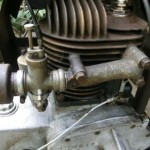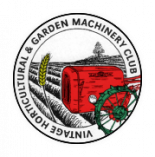Forum Replies Created
-
AuthorPosts
-
December 26, 2013 at 5:37 pm #4546
 wristpinParticipant
wristpinParticipantJust be aware that those cone clutches tend to be a bit sharp and either in or out and from memory the machine is quite high geared! Also you will see that there is a lubrication hole in the clutch drum covered by a small countersunk screw – do NOT put more than a couple of drops of oil down this screw hole because if you contaminate the cast iron cone and concave with oil they are a pig to “dry out”. Many years ago I had a customer leave his machine outside over winter standing on soil under a tarpaulin. The clutch seized and he soaked it in oil before calling us. We washed it all out and got it all working fine – so we thought. However as the clutch warmed up it “sweated” more oil that had been absorbed into the cone and concave material and we ended up having to dismantle it all again and heat both components up enough to drive the oil out and then wash it in solvent to clean it all up.
December 25, 2013 at 11:28 pm #4527 wristpinParticipant
wristpinParticipantSounds like a similar bit of kit!
Will pm you re the bottom blade.December 25, 2013 at 6:03 pm #4521 wristpinParticipant
wristpinParticipantMany years ago we had a local garage owner who attended a lot of government disposal sales and traded in all sorts of machine tools etc. At the rear of his garage there was this enormous vertical lathe/broaching/milling machine that was encased in a scaffolding and tarpaulin shelter as it was too big to fit in the building. The story goes that when Chatham Naval Dockyard was closing down he bought this bit of kit for a song and the Navy then discovered that it was the only thing that could carry out some machining operation on a particular type of gun turret slewing mechanism. He then became a sub-contractor carrying out all that work for the Navy and recouped many times his initial outlay. Sounds as though your man cutting the teeth on that gear wheel has something similar!
December 24, 2013 at 11:47 pm #4495 wristpinParticipant
wristpinParticipantRay, your post on link belts solves a mystery and brings back memories. The mystery was the tool shown on your link – I was looking at one in my tool box t’other day and wondering what it was for!
The memories go back to 1960 when I was working for a farmer who was into the latest thing – washed and pre-packed potatoes. The spuds were stored in one building and washed through flumes in the floor and under a farm access road to the washing and packaging plant using large volumes of recirculated water. This water came from a holding and settling reservoir and was moved by a large pump down in a pit driven by an ex-government 6-cylinder diesel above, Chrysler I think, connected together by a quadruple link belt drive.
One of my jobs was to wake the diesel up in the morning – copious quantities of “magic breath” and another was regular belt shortening sessions, aided not by the tool in the illustration but by one similar to a pair of pliers with flat right angle ends. Happy days!
Anyway, attached is a pic of the link belt installed to drive the fan on my spare Dennis engine.December 24, 2013 at 8:31 am #4464 wristpinParticipant
wristpinParticipantA bit of a long shot but in the absence of manufacturer data you just might get hydraulic oil info from the technical department of one of the oil companies. One of the smaller companies such as Morris Lubricants (my personal favourite for helpfulness) may have something in their archives.
December 23, 2013 at 9:50 pm #4432 wristpinParticipant
wristpinParticipantsounds like an idea for another wheelhorse project “amphibious wheelhorse” could be called a “seahorse”
Think that County beat you to that name with the one that crossed the Channel, fancy the challenge ?
December 23, 2013 at 7:48 pm #4423 wristpinParticipant
wristpinParticipantWorry ye not we are still hanging on tight down here in the South East (Dover). The way the weather has been today hibernating sounds a good idea!
Pretty rough round the corner from you Ray, the noise from the wind through the trees is quite frightening – good job that the leaves have gone.
Been out in the shed most of the day, door shut, radio on and kettle operational !
” On parade” tomorrow though.Best wishes to all and a peaceful Christmas and prosperous New Year.
AngusDecember 23, 2013 at 10:49 am #4409 wristpinParticipant
wristpinParticipantFinding an ex-employee is one route worth exploring but there will also be knowledge and maybe manuals out in the dealer and former dealer network. Ground care dealers such as Parkers of Worcester Park (do they still exist?) would have been familiar with that sort of kit.
December 22, 2013 at 4:21 pm #4377 wristpinParticipant
wristpinParticipantCan’t help with a manual but for what it’s worth I have never seen a Villiers 2 stroke mag with the points anywhere other than roughly the 7 o’clock position, the coil at 12 and the HT lead exiting at about 1.
December 22, 2013 at 12:40 am #4349 wristpinParticipant
wristpinParticipantYou can walk out to it at low tide – with care!
The wreck in question is a WW1 vessel but a good idea of just how bad the conditions were in such vessels can be gained by watching the classic WW2 film of the book Das Boot. It does go on a bit but I remember shots in the engine room showing diesels that seemed to stretch into the distance with exposed valve rockers etc.
https://en.wikipedia.org/wiki/Das_BootDecember 22, 2013 at 12:27 am #4348 wristpinParticipant
wristpinParticipantATCO = Atlas Chain Company.
Re the Concorde, that was exactly the point I was making. Made in their thousands and thrown away in their thousands! Don’t confuse rare, ie not many around, with quality or of value. Machines from the 1900s have survived because they were made from durable materials such as cast iron at a time when such things were valued and even if discarded in the back of the coal shed survived to be restored and cherished.
The Concorde was a “cheap and nasty” mass produced machine built more to domestic appliance than horticultural standards and as such was readily discarded or reverted to iron oxide!. It wouldn’t surprise me if far more Ransomes Ajaxes have survived than Concordes. However, it is representative of an era in UK manufacturing and gardening and as such a decent one is worth preserving.December 21, 2013 at 7:15 pm #4324 wristpinParticipant
wristpinParticipantAttaching a link to a general parts illustration and a bit about governor adjustment. Was going to include carburettor adjustment but although there are two types in the manual, neither are the one in your images!
EDIT – the Link has disappeared!!! try again!
Second edit – disappeared again!!!!!
Third edit – give up!! May be try it as an image
One last shot, just going to paste the url without using the “link” or “attachment” buttons
https://www.dropbox.com/s/suhkqdsleytpbfo/Villiers%20Mk250001.pdf
BINGO!
December 21, 2013 at 5:39 pm #4316 wristpinParticipant
wristpinParticipantWhoops, missed those, so it is a slide carb with the auxiliary butterfly controlled governor ! Found some Villiers gen on Mk25 governors which may be useful and will post it when back with the desk top puter.
December 21, 2013 at 2:51 pm #4299 wristpinParticipant
wristpinParticipantReport back tomorrow then?!
In the absence of an image it has belatedly occurred to me the you may well not have a carb with a cable controlled slide but just the auxiliary butterfly in the manifold and instead of the threaded rod being locked with a nut, a plain rod tensioned by the throttle cable?December 20, 2013 at 7:22 pm #4261 wristpinParticipant
wristpinParticipantAn image would help but as Andy says the throttle cable will operate the carb slide. As I said in my earlier post the governor arm may well just operate an auxiliary throttle butterfly in the inlet manifold. I that case it won’t have another cable and the sping connected to the governor arm will probably be anchored to a bracket – maybe via a threaded rod and lock nut to allow for adjustment of the top no load rpm.
An image of the governor arm etc will help.
Angus -
AuthorPosts

